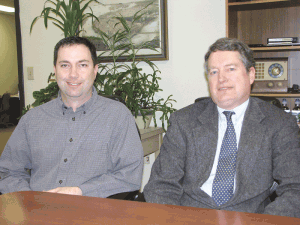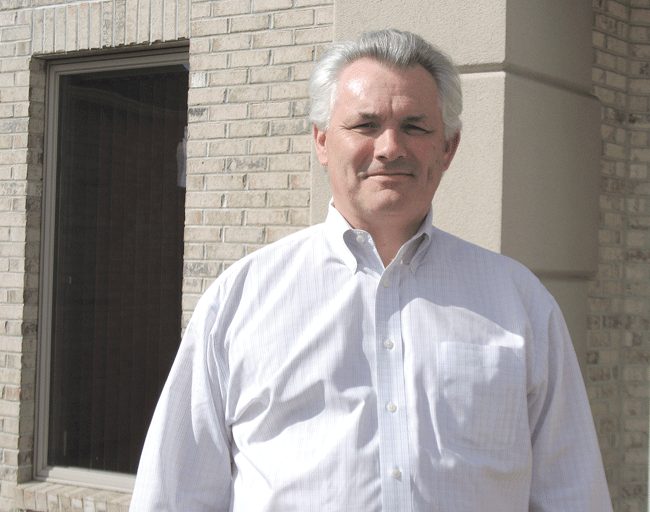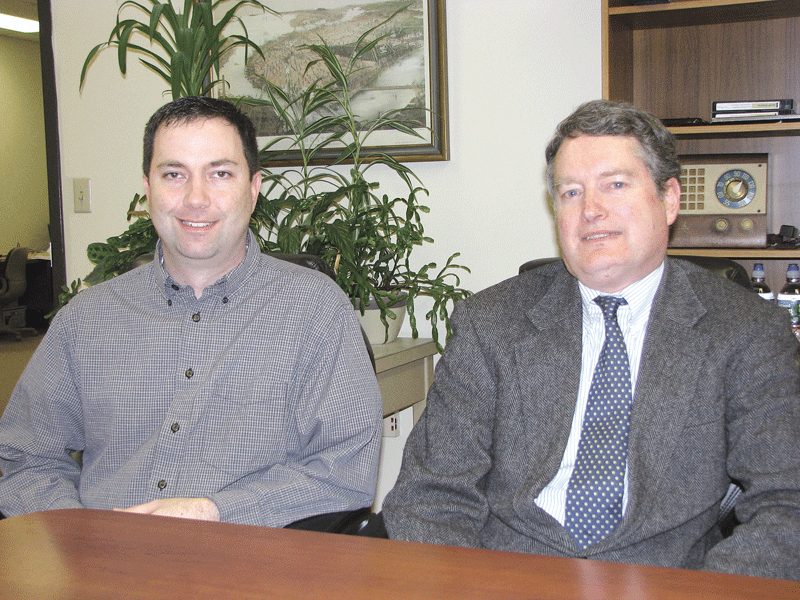Month: March 2012
Amherst Area Chamber Focuses on Brand Building

Tony Maroulis says protecting and enhancing the Amherst brand is now part of the mission for the Amherst Area Chamber.
And time and again, he came to the words ‘brand’ and ‘branding,’ which he used to describe not only his organization, but the town of Amherst itself and, especially, its historic, eclectic, and hugely popular downtown.
“The approach that we have taken, and the approach you have to take, is to establish what the core brand is,” said Maroulis, executive director of the chamber. “In Amherst, that is its downtown and the educational institutions. You have to keep that in mind when crafting any strategy.”
Building, protecting, and promoting the brand are critical to the success of everything from attracting and retaining businesses to luring tourists and retirees, to enabling the colleges and UMass Amherst — which give the area so much of its identity and vibrancy — to successfully recruit faculty and staff, said Maroulis, adding that such work also facilitates growth of other areas of Amherst and surrounding communities as well.
“If the strength of the downtown is at peak levels, and you have a visible vibrancy where people are coming, you know you’re driving on all cylinders,” he said. “That really starts to expand and extend to the health and vitality of South and North Amherst as well, and then the other communities.
“It’s about strengthening that brand, and that brand really is about Amherst. Not to detract from other towns, but you have to consider what people on a national level know about your brand identity. And they know Emily Dickinson, the colleges. You have to make sure that you keep that core brand strengthened.”
Historically, what was then called the Amherst Chamber of Commerce was founded in 1956 by a group of businessmen who banded together to forge partnership opportunities in their town. “Many of those families that were instrumental in forming the chamber at that time are still active in the community — the Jones family, the Puffer family. It has been an enduring institution, and one that has had participation from these families and others from generation to generation,” Maroulis said.
But, he noted, as the community has grown from its bucolic background into one of New England’s best-known college towns, the business sector, and the chamber, have evolved with it.
The chamber’s role has expanded over the years, he said, from a small networking organization that would stage fund-raisers and promote member businesses, into an agency that is increasingly about advocacy, and more involved in the politics and planning of the town and region. “We’re much more heavily invested than our role traditionally has been,” he said.
Over the past 10 years, beginning with one of his predecessors, John Coull, the ACC expanded to include some outlying districts that have an intrinsic connection to the Amherst hub — Hadley’s route 9 corridor, the Franklin County town of Sunderland — and, thus, the organization grew into its present name, and is now the AACC.
“There are, in fact, businesses from 20 surrounding communities who are members,” Maroulis said, “because they realize the importance of a presence here in this town.”
For this issue, BusinessWest looks at how Maroulis and the AACC have been getting down to business in order for that brand to translate to higher goals, both within the business community, but also into a philosophical and social dimension that some might deem outside the purview of a chamber of commerce.
Neighborhood Watch
Maroulis pointed to one of the best-known local examples of a civic brand: downtown Northampton.
“They’ve been building upon that since Thornes Market took off decades ago,” he explained. “That affected the commerce on King and Pleasant streets. But that also affected the decision of a business like Kollmorgen wanting to stay. And so, if the strength of the downtown — maintaining a quaint New England character, yet also its emerging urban type of feel and sophistication — is fully intact, then that’s going to mean we can attract businesses in our own outlying areas.
“They’re going to want to be here because that core is strong,” he continued. “They’re going to want to have that access to the businesses downtown, and also see their community members in the village square.”
Building upon the civic strength of Amherst requires some evolution. Adjacent to the downtown parking garage, a new construction, a five-story building nears completion. With retail at the ground level and residences on the upper floors, it represents the first project of this scope and size in Amherst in decades.
“This new building is exciting in many dimensions,” Maroulis said. “It proves that you can do infill projects, with zero-lot-line construction, right in downtown Amherst. That’s important not only to the development community, that it can get done, but also to the community at large, to let them know what the possibilities can be.”
Also in the final stages of completion is Amherst’s Business Improvement District. “The fact that downtown landlords are putting money into the enterprise of downtown is truly exciting,” he said. “They are creating something that is sustainable. This isn’t membership-based; everyone is opting in, and they’re sticking it out as long as they have those buildings. It says a lot about the dedication of those participants.
“Those landlords’ faith that we can continue to move our downtown forward is important,” he added. “And it’s a hugely positive sign. As we promote this brand, having that sustainable resource to maintain it on a regular basis allows downtown to continue to be competitive in the marketplace.”
Community Action Plan
Maroulis noted that, at peak levels, pre-recession, the AACC numbered somewhere around 650 members. “We’re back down to around 520, 550,” he added. “So we’re still pretty strong. That’s reflective of the strength of this community, and for one great reason, we can thank our educational institutions.”
The public school system for the Amherst region is legendary for its academic excellence. But he allowed that the town is sensitive to its social needs.
“Nearly 40% of our school-age population is on free or reduced-price school lunches,” he explained. “And there is a significant percentage of our population that is right around the poverty level. If we don’t address some of these issues, we simply can’t continue to be competitive. And that’s why it is so important to be forward-thinking now.”
When pressed to explain the role of a chamber of commerce in such a sociopolitical forum, Maroulis said the answer was far simpler than the problem itself.
“The chamber is an organization that is very close to the culture and norms of our backyard,” he said. “It’s not just business for business’ sake, or just for profit’s sake. As we are reflective of what our community looks like, we’ve been involved, and we continue to get involved, in all facets of this conversation. I don’t think it is a big jump to wonder, if you have a poor school system, how does that affect the real-estate market?”
That reasoning is also reflective of other aspects of the town’s vibrancy. “This is key to attracting faculty who want to come here — generally speaking, not making the same money that they may make in a larger research university,” he explained. “We have some very talented faculty who could just as easily be teaching at Ivy League schools, but they have chosen to be here for the quality of life.
“I’ve had many of my professor friends talk about the sacrifices in terms of salary, but the quality of life and the excellent school system were significant draws,” he added. “If that school system erodes, how much harder is it to continue to attract that caliber of faculty?”
Planning for the Future
Maroulis joked that, in another lifetime, he might want to be an urban or town planner. Zoning and master-plan agendas with regard to working, walkable village centers have been on the front burners of the AACC as Amherst negotiates its town, gown, and development issues.
He credits the generational breadth of his board for both its legacy and its visionary abilities in maintaining the concept of the town’s strong brand, which has and will continue to have currency in these ongoing conversations. While some business families have been active for decades, there is a younger group of professionals that will ensure that the AACC remains vital well into the future.
Maroulis added that partnerships with other regional organizations have a symbiotic relationship with the college town’s business community — not just the newly created BID, but the Greater Northampton Chamber of Commerce and their collaboration to start a Hampshire County Regional Tourism Council.
“What we are is about community,” he said. “And we stress, both from our mission and in our actions, that being a part of something larger, participating in that, is a long-term blueprint for success. You can’t be on an island by yourself.”
Home & Garden Show Offers Businesses Valuable Exposure

Brad Campbell says the home show is a valuable source of funds for the Home Builders & Remodelers Assoc., but more critical as a marketing tool.
“I know of one foam-insulation company that gets 60% of its business from the home show,” said Campbell, president of the Home Builders & Remodelers Assoc. of Western Mass., the organization that has been putting on the show for the past 58 years. This year’s event takes place on March 22-25, at the Eastern States Exposition.
That 60% figure isn’t an isolated example, he told BusinessWest. For some companies, the leads generated over those four days may account for up to 70% of their business for the year.
“The home show gives vendors the opportunity to market to an audience that normally wouldn’t see their name,” he explained. “They get in front of consumers for four days — more than 20,000 consumers, in fact. That, by itself, is a tremendous value.”
That exposure is, in many ways, a reflection of the goals of the association itself, Campbell noted.
“We’re an independent group made up of builders, remodelers, and what I call allied industries, industries that support builders and remodelers,” he said. “We have about 400 members, and our purpose is to represent the interests of those industries, both legislatively and by helping our members develop themselves as stronger business people. We offer education to our members to try to help them run their business more effectively and efficiently.”
The home show, he explained, started as a way to generate revenue to support the association.
“Like any trade group, we’re supported by dues from members. We try to keep dues as low as possible, and the home show has been able to be our funding mechanism to accomplish that. But that’s a minor point; the real purpose of the home show is that it gives the community the opportunity to see and touch and feel these new products we’ve developed, and incorporate them into their homes. It’s developed over the years to be a spotlight for these products and services.”
For this issue, BusinessWest sits down with Campbell to learn how the Home & Garden show continues to evolve in its 58th year, and why it continues to be that vital lifeline — or, at the very least, a springboard into a busy spring — for so many companies.
Bricks and More
The scope of the home show has definitely expanded, Campbell explained, noting that it’s no longer just a showcase for new products and construction- and landscaping-related services. Visitors can learn how to finance their projects by visiting one of a whopping 10 banks and credit unions that will set up shop at the show. Other exhibitors — more than 350 in all, in more than 90 different categories — run the gamut from inspection services to security and alarm systems; Internet and communications to moving and storage; duct cleaning to pianos and organs.
“We even have automobiles at the home show,” he added. “It’s no longer just about homes; it’s about lifestyle, how we live our lives, whether it’s improving our backyards, creating an escape from the day-to-day, or the vehicles we drive, or the sheds we put things in. Sheds have also become a big portion of the show.”
The theme of this year’s show is ‘Rebuilding Western Mass., Rebuilding Lives,’ a nod to a freak series of weather events last year that turned countless lives upside down across the region.
“A lot of consumers haven’t figured out how they’re going to do it,” Campbell said in reference to said rebuilding. “This is a place where they can talk to professionals, talk to suppliers, architects, and find a way through the maze of how to get back on their feet.”
Responding to the storms of 2011, he noted, some fields (roofing and siding, for instance) were booming from the get-go, but much of the new construction still hasn’t happened because property owners and insurance companies continue to deal with claims, so there’s plenty of opportunity on the table for companies in dozens of specialties. “A lot of people were underinsured or uninsured,” he added. “We’ve all heard horror stories. It’s been interesting.”
That brought Campbell back to one role of the Home Builders & Remodelers Assoc., and that is as a resource for consumers looking for construction services. The home show, he said, is one way to get that message across, by enhancing the group’s profile.
“That’s one thing that gets lost about our association,” he noted. “When consumers are trying to figure out which builders or remodelers to use, when they have questions, we’re possibly the best source for that information. When consumers call, we do the research. We have a referral program for our members, so when a consumer calls and wants work done on their home, we’ll find a member willing to do the work. Sometimes people think of the Yellow Pages first, but here, we’ve got the resources.”
Solar Proprietors
Those consumer questions often center around options for energy-efficient products, an increasingly noteworthy trend in building. At the home show, that’s reflected in everything from solar and geothermal products to a company like Eco Building Bargains, which specializes in repurposing discarded building supplies.
“We’re seeing more technology, more energy-efficient products,” Campbell said. “That’s what consumers are looking for. This year we have three or four solar companies, where in the past we’d have one. High-efficiency heating and cooling systems always play a big role.”
Also on the rise at the show — perhaps reflecting an improving economy — are luxury items, from pools and hot tubs to central vacuum systems and other gadgets that make home life a little easier.
Speaking of making life easier, Campbell’s organization aims to do just that for area nonprofits, many of whom are offered free booth space at the show. The Home Builders & Remodelers Assoc. has partnered in the past with the Red Cross, Shriners Hospital, Rebuild Together Springfield, the American Cancer Society, Habitat for Humanity, Harmony House, and many others. It also maintains a scholarship program for members’ children, which has doled out some $400,000 to date.
“We try to give nonprofits the opportunity to get in front of people and explain who they are and what they do; that’s an important component of community service that we’re promoting heavily,” he explained.
This year, the association is working with Homes for Our Troops to build a house in Granby for Marine Sgt. Joshua Bouchard, who lost his left leg and broke his back after his vehicle drove over an explosive device in Afghanistan in 2009.
Efforts like that, Campbell said, make it clear that “the culture of home shows is such not just about doing business. One thing I’ve found is that people actually go to these to see old friends, people they haven’t caught up with in recent years. It’s a social event as well as a consumer event.”
And if it helps to rebuild a few lives — from tornado victims to an injured Marine — then it’s a show even more worth seeing.
Joseph Bednar can be reached at [email protected]
Design Professionals Navigates Shifting Landscape in a Competitive Field

Peter DeMallie (right, with Ben Wheeler) says factors like ADA compliance and ecological concerns have made landscape architecture more complex over the years.
“Landscape architecture is not just selecting plant species and outlining them on a map of the property,” said DeMallie, president of Design Professionals Inc. “That’s a very small component of what landscape architects do.”
Rather, the projects his company tackles tend to be much larger in scale, with significant elements of civil engineering, site planning, and land surveying, some of the other specialties of this South Windsor, Conn.-based firm.
“The crux of our landscape-architecure business supports our other disciplines, our civil-engineering and land-surveying business, and most of that work is for commercial and industrial clients,” said Benjamin Wheeler, a landscape architect and director of Operations for the company.
Design Professionals, which celebrated 25 years in business last year, has worked on more than 2,500 projects in more than 120 communities in Connecticut, Massachusetts, and Rhode Island, encompassing residential, retail, office, and industrial sites, as well as schools, churches, parks and sports fields, and municipal facilities.
“We average 100 new projects a year, and that’s over all disciplines,” DeMallie said. “Not all those have a landscape-architecture component, but a large number of them do.
“We aren’t the type of firm that goes into somebody’s backyard,” he added, before correcting himself somewhat and detailing some relatively larger-scale residential jobs. “They’re primarily high-end residences looking for professional designs in and around the pool, associated landscaping, waterfalls … we can do that, but typically for the higher-end market.”
In fact, residential work used to be a larger portion of the business, before the housing market collapsed in 2008 and launched the Great Recession.
“The demand for services dropped off appreciably during the recession, and even after the official recession end. The economic impact to our business, to the design marketplace, was heavily impacted,” DeMallie said.
Many anticipated projects were backlogged, he explained, and residential work in particular suffered; “as for single-family subdivisions, we have worked on one in the last three years. Forty percent of our business used to be residential; now it’s probably under 20%.”
Still, Design Professionals has stayed busy with projects ranging from a Fedex Ground distribution center in South Windsor to the design of the Farmington Sports Arena, which features a mix both natural- and artificial-surface fields.
DeMallie and Wheeler recently sat down with BusinessWest to talk about how the company has grown over the past quarter-century, and particularly how the business of landscape architecture has changed over that time. It’s a complicated field, to be sure, even though the outcome is often fun and games.
Green Acres
One current job that is strictly a landscape-architecture project involves extensive work at South Windsor High School, bringing the grounds and athletic fields up to code, including handicapped access under the Americans with Disabilities Act.
“ADA compliance is a component of every single project now, whether public or private sector, whether it’s an educational facility, police station, industrial facility, office space, you name it,” said DeMallie. “It’s one of the many challenges for every site.”
Another major shift has been the increasing prominence of ecological concerns over the past few decades, and the expanding maze of regulatory hassles that surround those issues.
“Environmentally, if you think back as late as the 1960s or even the 1970s, wetlands was not a major factor,” he noted. “But preservation of inland wetlands has grown — the recognition of those sites as important environmental assets. Wetlands on site or adjacent to the site have become a major issue. The idea is to avoid the impact of wetlands, but if it can’t be avoided, you must minimize the impacts and justify the impacts.”
“Erosion control and sedimentation control were an afterthought years ago,” he added. “Now it’s standard operating procedure.”
He laughed when he evoked the pre-1970 view of filling in a wetland as a positive thing — “you were just removing mosquitoes. It has changed a lot.”
Wheeler said “low-impact development” has become a watchword, and referred to a retail project in Easthampton, Conn. that was approved under new local parking-lot regulations. One component of those guidelines is that stormwater runoff is directed into ‘rain gardens’ rather than into underground systems. “The gardens are planted with material that’s appropriate and can tolerate both moist and dry conditions.”
The benefit, he explained, has to do with keeping runoff, which may contain anything from fertilizers to debris from the metals on cars, out of the municipal water system.
“Another trend in site design, also part of the green movement, is that you’re seeing more use of LED lighting for [outdoor] fixtures,” he explained. “The technology is those is rapidly improving, so much that I think, in a very few years, we’re going to see even more extensive use of LED lights for site lighting. We’re not quite there in all projects, but in certain situations, it does make sense.”
DeMallie noted that the costs of such amenities are coming down as well, and site owners are always looking to affect the bottom line.
“You can save a lot on energy efficiency,” Wheeler said. “You spent more on the install, but there’s a long-term return on investment.”
Breaking New Ground
The sheer range of the firm’s portfolio is impressive. “Every retail development has a landscape-architecture component,” DeMallie said. A good example is Buckland Commons in South Windsor, a two-building project in South Windsor that includes a bank, retail space, and offices.
“As a landscape architect, I worked to develop multiple concepts for the property, and after one concept was selected, we moved forward with the local approval process,” Wheeler explained. “The site design included signage, determining plant species and their proper location, also a decorative screening wall. I also helped determine the appropriate amount of lighting for the site and worked closely with soil scientists to come up with a wetland mitigation plan, because there was some direct wetland impact with that project.”
That’s a good example of the range of skill sets that go into many commercial, industrial, and municipal projects — it’s no surprise that the Landscape Architecture program at Ohio State University, where Wheeler earned his degree, is housed in the School of Engineering. “It’s a pretty diverse profession,” he said. “I’m constantly working with engineers and surveyors on projects.”
But, again, not as many residential projects as in the past. DeMallie said it’s not just the housing market that has impacted that side of the business, but inadequate long-term planning by communities, with plenty of McMansions and over-55 housing erected over the past decade or two, but not nearly enough affordable homes for young professionals.
“That’s one of the problems in the Hartford and Springfield area,” he said. “The farther you go out from Hartford and Springfield, beyond the heavily urbanized city and suburban areas, as you get into the exurban areas, there’s still land available — but most don’t have full utilities to support it.
“It’s no surprise to anyone that this region has lost some of its young workforce, and one reason is that we don’t have the housing projects to meet their desires and needs, as well as affordable mass transit. It affects our ability as an employer to attract and retain employees with the skill sets we want.”
Still, the company has navigated changes in its industry before, and will continue to do so as the impact of the recession begins to lift. After all, the landscape is always changing — and Design Professionals continues to shape it.
Joseph Bednar can be reached at [email protected]
PeoplesBank Surpassed $1 Million in Charitable Giving in 2011

Tom Senecal visits with students at Square One in Springfield. PeoplesBank donated $25,000 to the organization to help it recover from the June 2011 tornado.
After all, the bank committed $200,000 for relief efforts in the wake of the June 1 tornadoes that devastated neighborhoods in Springfield, West Springfield, Westfield, Monson, and other communities.
But Senecal, the bank’s chief financial officer, believes the Holyoke-based institution probably would have reached that milestone even if the region hadn’t been visited by those twisters, which created needs that probably couldn’t have been imagined on May 31.
That’s because the needle had been moving steadily toward that number for the past several years — donations totaled $850,000 in 2010 and $705,000 in 2009 — and also because the bank had a very solid year with regard to the bottom line, and sought to redirect profits back to the community as a reflection of the culture at the 127-year-old bank — and to address growing needs in many areas, said Senecal.
“We were seeing a tremendous need in all the communities we do business in,” he told BusinessWest. “Some of it was related to the tornadoes, but it was across the board, really, from gifts to several senior centers to donations to hospital capital campaigns.
“We’re a mutual institution, and we do not have stockholders,” he said. “We believe, as a result of that, that it’s our responsibility to give back to the communities we do business in.”
And while surpassing the $1 million mark is a noteworthy achievement, like the bank’s consistently high ranking on the Boston Business Journal’s listing of the most charitable companies in the state (38th in the last survey), what’s behind that number — meaning the direction this philanthropy takes — is the more significant story, he told BusinessWest.
Indeed, the bank continues to focus its efforts on three major areas — health care, education, and what he called “environmentally friendly initiatives,” with that latest category being a far-more-recent phenomenon, meaning the past decade or so. The weather calamities, especially the tornado, created new types of need, Senecal noted, and new and different ways for PeoplesBank to lend its support to the community.

Susan Wilson, vice president of Marketing at PeoplesBank, tours the new Leverett Elementary School greenhouse that was funded by a donation from the bank.
“We made that donation to Square One within the first week after the tornado struck to help with emergency needs that they had within the community,” he said, adding that contributions were also made to a number of organizations involved in relief efforts, such as the Red Cross, the Community Foundation, and others.
But, as Senecal said, there was more to the bank’s surge past the $1 million mark than the wrath of Mother Nature.
Indeed, 2011 was a year when state and especially federal budget cuts hit a number of nonprofit agencies quite hard, said Senecal, adding that PeoplesBank stepped forward to help many of these institutions.
“Government cutbacks have forced nonprofits to seek alternative sources of funding so they can continue their missions,” he said, adding that more reductions are likely in the years ahead, meaning that need will continue to increase.
There was also the bank’s ongoing expansion, he said, noting that, when the institution widens its reach into a different community or neighborhood, it punctuates its presence with donations targeted for that area. This trend was continued recently in Springfield and West Springfield (the bank opened its latest branch there last year), and it will be witnessed in Northampton when it opens its first full-service branch there (and 19th overall) later this year.
“We reach out to the community to find causes that can have as much impact as possible in the cities and towns in which we do business,” he said of this pattern, adding that the ongoing expansion efforts are a big reason why overall donations within the Western Mass. region have increased more than 40% since 2008.
Looking back on 2011 and reaching the $1 million milestone, he noted that that there were donations made to roughly 400 organizations. Many were tornado-related in some way, he continued, noting that a total of $80,000 was donated to five communities for so-called “re-greening efforts.”
Overall, though, contributions were focused on those three main areas of concentration, said Senecal, noting that, in health care, donations were made to senior centers, hospitals, other care providers, and specific initiatives to improve the overall health and well-being of area communities.
There were many contributions in the broad realms of education and the environment as well, he went on, adding that some managed to overlap.
Such was the case with a donation put toward the building of a greenhouse at the Leverett Elementary School in Leverett, Mass.
But Senecal stressed that donations to the community are not limited to checks from the bank, or monetary contributions.
Indeed, PeoplesBank employees were ranked third in the state by the Boston Business Journal in terms of charitable giving from their pockets, and fourth when it comes to volunteer hours donated within the community, statistics that are a big part of the bank’s philanthropic track record.
“When you talk about a corporate culture of giving, it’s not just at the president’s level or the PeoplesBank level,” he explained. “It comes from all the employees.”
— George O’Brien
Know the Rules to Avoid Costly Workers’ Compensation Risks
By DAVID MOTOSKY, CRM
There is no doubt that the cost to employers of providing workers’ compensation insurance benefits for their employees can be a significant budget line item. Just as significant can be the potential cost to employers when they hire non-employees within the usual course and scope of their business operations who might be uninsured for workers’ compensation, without even knowing it.Whether an employer hires casual labor to help complete a specific project, contracts with a subcontractor to provide specific services to the employer, or hires an independent contractor to perform direct work for or on behalf of the employer, workers’ compensation laws are pretty clear. In the vast majority of cases, an employer will be held responsible for workers’ compensation benefits payable to uninsured ‘contractors.’ But there is an easy way for employers, regardless of their business or industry, to practice sound risk management and avoid the potential of having their loss experience and workers’ compensation insurance costs negatively impacted by workers who aren’t on their direct payroll.
Requiring a current and valid certificate of insurance evidencing proof of workers’ compensation insurance from anyone who does work for you is a simple and practical way to reduce your potential exposure in this area.
In Massachusetts, it is presumed that any person performing services for another is an employee unless the employer can meet the following three-part test:
• One, the individual is free from control and direction in connection with the performance of the service, both under his contract for the performance of service and in fact;
• Two, the service is performed outside the usual course of business of the employer; and
• Three, the individual is customarily engaged in an independently established trade, occupation, profession, or business of the same nature as that involved in the service performed. An employer’s failure to demonstrate all of the above sufficiently establishes an employer/employee relationship under the law.
Let’s first get a clear understanding of the two basic components that directly impact an employer’s workers’ compensation expenses: the direct insurance premium cost to the employer, and the employer’s loss experience. In theory, there is a direct correlation between the two. To the extent that loss experience is favorable, the premium cost will be low. Conversely, to the extent that loss experience is poor, the premium cost will be high.
There are three premium-bearing components that directly impact an employer’s workers’ compensation insurance premium cost: annual payroll, manual-class-code rates, and the employer’s experience-modification factor (and its companion ARAP surcharge, if applicable).
The annual payroll amount is initially estimated by an employer prior to the inception date of the policy, and is subject to audit at the end of the policy term. Payroll includes salary, wages, two-thirds of overtime expenses, casual and temporary labor costs, and payments made to subcontractors that are uninsured for their own workers’ compensation exposures. There is a direct correlation between payroll and premium — the higher the payroll, the higher the premium; the lower the payroll, the lower the premium.
The manual-class-code rates are set and established by the Mass. Workers’ Compensation Rating and Inspection Bureau, and subject to approval by the Mass. Division of Insurance. There are hundreds of class codes, each assigned to a specific classification, that recognizes the predominant work functions of an employee. At the inception of each policy term, the manual class-code rates are applied to the annual payroll amount per classification of employees, per $100 of payroll, to calculate the manual premium. At expiration of each policy term, the insurance company will perform an audit of the payroll to determine the actual classification and payroll exposures during the policy term.
The insurer will charge additional premium if payroll was underreported, or refund premium if payroll was overestimated, subject to any class-code minimum premium. There is a direct correlation between the manual-class-code rates and premium — the higher the rates, the higher the premium; the lower the rates, the lower the premium.
Insurance companies can file for approval of rate deviations from the established manual rates. In what is referred to as the voluntary insurance market, deviated rates are readily available and plentiful. Policies written through the Mass. Workers’ Compensation Assigned Risk Pool (MWCARP), the market of last resort in the state, are written with only the manual rates applied, without the potential for savings of deviated rates, or premium discounts, for that matter. In general, employers with favorable loss experience have many options available in the voluntary market, whereas employers with poor loss experience or high hazard operations end up in the pool.
An experience-modification factor, and any companion ARAP surcharge, is calculated on an annual basis by the Mass. Workers’ Compensation Rating and Inspection Bureau (WCRIB) for each employer, prior to the inception of each policy term. The experience-modification factor is applied to manual premium to calculate standard premium. Any applicable ARAP surcharge is then applied to the standard premium to calculate the additional surcharge. Those employers that operate in multiple states in addition to Massachusetts have their calculations performed by the National Council on Compensation Insurance (NCCI), using the same basic formula. For smaller employers that aren’t eligible for experience rating, a merit-rating calculation is performed by the WCRIB. Merit rating acts in a similar fashion to experience rating.
In very basic terms, an experience-modification factor, and any companion ARAP surcharge, rewards an employer that has favorable loss experience by applying a credit to their premium, and penalizes an employer which has negative loss experience by applying a debit to their premium. There is a direct correlation between the experience-modification factor and premium — the higher the experience-modification factor, the higher the premium; the lower the experience-modification factor, the lower the premium.
An experience-modification factor of 1.0 is neutral, with no credit or debit applied. An experience modification factor of 1.1 applies a debit of 10% to premium. An experience modification factor of 0.9 applies a credit of 10% to premium.
Prior to Oct. 23, 2002, sole proprietors and partners of legal partnerships were unable to cover themselves as employees under a worker’s compensation policy that they purchased. The change to M.G.L. Chapter 152 allowed a sole proprietor or partner to elect coverage; otherwise they would not be covered under the policy for any work-related injury. If coverage election is made, the minimum payroll for premium computation purposes for each respective employee is set by the state on an annual basis, based upon the state’s average weekly wage (AWW). Currently, this minimum payroll amount for policies effective Oct. 1, 2011 and after is $41,300, even if the actual payroll is less.
At the same time, the change to M.G.L. 152 made it possible for certain corporate officers and directors to exempt themselves from coverage by applying to the Mass. Department of Industrial Accidents (DIA) for approval. If approved by the DIA, the payroll of the respective officer or director would not be included for premium-computation purposes. The officer or director must own at least 25% of the issued and outstanding corporate stock. If the corporation has no employees, other than those officers that have exercised their right of exemption, the corporation is not required to carry workers’ compensation insurance. If the corporation has other employees, or subsequently hires an employee, they must secure coverage in compliance with M.G.L. Chapter 152.
Any newly formed corporations are encouraged to consider the right of exemption and file Form 153 with the DIA for approval in a timely manner. Otherwise you run the risk of being issued a stop-work order (SWO) by the DIA. Over the past several years, the DIA has been aggressively investigating employers to ensure the existence of valid insurance in compliance with the law, issuing SWOs and assessing fines for noncompliance.
In January 2004, the DIA clarified that legal partnerships include LLCs and LLPs, and therefore the members of an LLC and the partners of an LLP may also elect to carry workers’ compensation insurance coverage for themselves. As is the case with sole proprietors, if coverage election is not made, there will be no coverage under the policy for any work-related injury.
Certificates of insurance evidencing workers’ compensation that are issued to sole proprietors and legal partnerships should list on them whether or not the sole proprietor or partners have elected coverage or not. If the certificate of insurance you are provided is silent as to the election of coverage, you are encouraged to contact the insurance agent or insurance company that has issued the certificate for clarification.
A word of caution when it comes to certificates of insurance and your reliance upon them — they may not be worth the paper they are printed on. They only provide a snapshot of the insurance coverage in force at the instant ‘print file’ was hit. Since that time, the policy could have been cancelled for misrepresentation or non-payment of premium.
The bottom line is that every employer should require, track, and maintain on file certificates of insurance from any person or employer that they enter into contracts with. Otherwise, a potential work-related injury to an uninsured employee will negatively impact your loss experience, increase your experience modification factor, and certainly increase your workers’ compensation insurance cost for years to come.
If you ever have any questions or concerns regarding the validity of a certificate of insurance, or how hiring a subcontractor or independent contractor might impact your own workers’ compensation insurance policy and its cost, your best bet is to rely upon the advice of your local independent insurance agent.
David Matosky is operations director for First American Insurance Agency in Chicopee, and has earned the designation of certified risk manager;
[email protected]
How This Tax-saving Vehicle Can Work for Your Company
If your closely held company earns significant income from exporting US-made products — or from engineering or architectural services on foreign construction projects — consider forming an interest charge domestic international sales corporation (IC-DISC).Although exporters often think of newly produced property as export property, used equipment and even scrap also qualify.
In its most recent form, the IC-DISC can provide a permanent 20% tax savings (or even more) for qualifying U.S. exporters. In certain cases, it eliminates U.S. tax entirely on the majority of export income. In addition, distributions to individual shareholders are currently taxed at a maximum rate of 15% — providing a way to convert 35% ordinary income to 15% qualified dividend income. Of course, this assumes that the U.S. exporter generates operating profits and is creating taxable income in the U.S.
To make the most of this strategy, it’s a good idea to act soon. An IC-DISC is relatively inexpensive to set up and operate, and it can reduce your federal tax rate on a portion of net export income by up to 20 percentage points. This differential was originally set to expire on Dec. 31, 2010, but Congress extended it in late December 2010 to Dec. 31, 2012.
Many practitioners strongly believe that this differential will be extended past 2012 even if tax rates on ordinary income increase. In addition to benefiting sole proprietorships and pass-through entities, exporters operating their business via a C corporation can benefit by using the IC-DISC to eliminate double taxation on a majority of their export income, as well as to reduce the need to incur additional payroll taxes on income paid to their shareholders or officers. The IC-DISC is not a tax shelter.
What Is an IC-DISC?
An IC-DISC is a ‘paper’ entity used as a tax-savings vehicle. It is a domestic C corporation, but must request and receive IRS approval to be treated as an IC-DISC for federal tax purposes. It also must maintain its own bank account, keep separate accounting records, and file U.S. tax returns. It does not require corporate substance or form, office space, employees, or tangible assets. It simply serves as a conduit for export tax savings. An important feature of the IC-DISC is that shareholders can be corporations, individuals, or a combination of these. The IC-DISC can be incorporated in one of the 50 states or in the District of Columbia.
How Does It Work?
The owner-managed exporting company forms a special U.S. corporation that elects to be an IC-DISC. The election is made on IRS Form 4876-A, which must be filed within 90 days after the beginning of the tax year. Here are more specifications:
• The exporting company pays the IC-DISC a commission;
• The exporting company deducts the commission from ordinary income taxed at up to 35%;
• The IC-DISC pays no tax on the commission as long it passes two main tests known as the qualified export receipts test and the qualified export assets test. The qualified export receipts test requires that 95% of the gross receipts of the IC-DISC constitute qualified export receipts. The qualified export assets test requires that 95% of the assets of the IC-DISC be qualified export assets. Qualified export assets include accounts receivable, temporary investments, export property, and loans to producers.
• Shareholders of an IC-DISC are not taxed until the earnings are distributed as dividends. However, the shareholders must pay annual interest on the tax deferred. Shareholders that are individuals pay income tax on qualified dividends at the capital-gains rate of 15%. The result may be a 20% or more tax savings on the commission.
The following calculation shows how the owners can save a combined $500,000 in federal income taxes. Let’s assume an S corporation has $20 million in qualifying export sales and $5 million in net export income on those sales. If the company has an IC-DISC subsidiary, it can pay the IC-DISC commissions up to the greater of 50% of its export net income or 4% of its export gross receipts. In this case, the maximum commission is 50% of net income, or $2.5 million. The S corporation shareholder has reduced pass-through income by the $2.5 million commissions expense. At 35%, this is a reduction of $875,000.
Assuming the IC-DISC fully distributes the commission as a dividend, the shareholder will have $2.5 million of qualifying dividend income taxed at 15% or $375,000. The net of these two items is the $500,000 tax savings.
For U.S. exporters, the IC-DISC is the only remaining tax-saving opportunity. If you are unsure about whether or not an IC-DISC will work, ask the following questions:
• Do you have any transactions outside of the U.S.?
• Do you use overseas distribution?
• Does your product cross any borders?
• Are you generating operating income?
If the answer to any of these questions is yes, an IC-DISC could be a valuable tax-savings vehicle for your business.
On the surface, the rules covering the IC-DISC may seem simple. However, to maximize the tax benefit, a qualified IC-DISC advisor should be engaged. Many times an IC-DISC expert can double if not triple the tax benefit the IC-DISC provides by applying their indepth understanding of how to structure the IC-DISC and using the complex advance pricing rules that the Internal Revenue Code allows for determining the tax benefit. A firm that has proven IC-DISC expertise, offers fixed fees, and optimizes the IC-DISC on a transactional basis (which almost always provides the best result) should be chosen.
Kristina Drzal-Houghton, CPA, MST, is the partner in charge of Taxation at Holyoke-based Meyers Brothers Kalicka, P.C.; (413) 536-8510.
Many Homeowners Facing Foreclosure Won’t Be Helped by This Deal
From the beginning of 2007 until early 2012, approximately 4 million families lost their homes to foreclosure. While the wave of foreclosures was unsettling, the stories that emerged in 2010 about the process being riddled with sloppy recordkeeping were far more disturbing.These issues came to light because of the practice known as ‘robo-signing,’ through which families lost their homes based on forged or unreviewed documents. After a year of investigations and negotiations, state attorneys general and the federal government announced a $26 billion settlement with five of the biggest mortgage lenders over improprieties ranging from robo-signing to failing to negotiate in good faith with homeowners. Those lenders include Bank of America, JPMorgan Chase, Wells Fargo, Citigroup, and Ally Financial. How did we get here, and what does this settlement offer? Let’s take a look.
Over the past decade, home ownership exploded across the U.S. Banks and other lenders spent billions of dollars to develop a seamless operation that took new mortgages, bundled them into securities, and sold them as investments. While I’m not going to get into the depth of shenanigans involved in this approach, suffice it to say things did not work out as the lenders and investors anticipated. When borrowers began to default, banks found themselves in a game of catch-up, and they failed to devote enough manpower to deal with the magnitude of the crisis. The institutions’ inability to keep up with homeowners’ requests for workout agreements forced them to cut corners.
When lenders began robo-signing foreclosures, they landed in the crosshairs of just about every consumer advocate and lawmaker. Instead of the required review of documents, lenders had automated the process, and inadvertently begun foreclosing on homeowners who were not in default, or owed no money.
That’s the background; now let’s review the settlement. The terms require the five lenders to contribute at least $10 billion for reducing the principal on loans for borrowers who are either delinquent or at imminent risk of default and are underwater — meaning they owe more on their mortgages than their homes are worth. At least $3 billion is earmarked for refinancing loans for borrowers current on their mortgages and underwater. Up to $7 billion will go toward other kinds of assistance, including forbearance of principal for unemployed borrowers, anti-blight programs, and short sales.
One of the more controversial portions of the settlement is the $1.5 billion set aside for cash payments to borrowers whose homes were sold or taken in foreclosure between Jan. 1, 2008 and Dec. 31, 2011; officials estimate that as many as 750,000 borrowers could receive checks for $1,500 to $2,000, which barely covers the costs of title insurance or moving.
The settlement also calls for $3.5 billion to be used to repay public funds lost as a result of servicers’ misconduct and to fund housing counselors, legal aid, and other public programs determined by the attorneys general. However, many states are already considering those funds to fill budget shortfalls or help with other problems, such as prolonged unemployment. An additional $1 billion will be paid by Bank of America to resolve a separate federal investigation related to alleged wrongful conduct involving inflated appraisals of Federal Housing Administration-insured mortgages. Half of that $1 billion will be used to fund a loan-modification program for Countrywide borrowers who are underwater on their mortgages.
Federal and state officials promoted the settlement as a significant step in holding the banks accountable for abusive and illegal foreclosure paperwork practices, and one that will provide relief to homeowners. However, despite the billions secured to help homeowners, the aid will help a relatively small portion of the millions of borrowers who are delinquent and facing foreclosure, especially since mortgages owned by the government’s housing-finance agencies, Fannie Mae and Freddie Mac, will not be covered under the deal. That excludes about half the nation’s mortgages.
The door is still open for further actions against the banking industry. Prosecutors and regulators still have the right to investigate other elements that contributed to the housing bubble, like the assembly of risky mortgages into securities that were sold to investors and later soured, as well as insurance and tax fraud.
How will this all play out? Only time will tell.
Thomas J. Fox is the community outreach director at Cambridge Credit Counseling, an Agawam-based professional housing and debt-counseling agency. He is an AFCPE-accredited credit counselor and an NCHEC-certified housing counselor; (413) 241-2362; [email protected]; twitter.com/thomasjfox
Measure Reforming Alimony Is Certainly History in the Making
Get ready, payers and recipients — a new statute is in town, and after so many years, it’s finally about alimony.
In an historic move, Gov. Deval Patrick signed into law “An Act Reforming Alimony in the Commonwealth,” which went into effect March 1. This Massachusetts statutory law, known as M.G.L. c. 208, §§ 48-55 inclusive, defines alimony, classifies it prospectively into four categories, and applies retroactively to existing orders. Gone are the days of unjustified lifetime alimony awards, the extension of alimony past the payer’s retirement age, and the ability of a recipient spouse to receive alimony during their cohabitation with another.
Understandably, judges and lawyers alike are both excited and nervous with such a tremendous new practice tool. From the court’s perspective, the apprehension stems from both its ability to handle the imminent floodgate of litigation and the amount of judicial discretion inherent in the wording of the statute itself. From the lawyers’ perspective, it’s the unknown judicial interpretation of the law to each specific fact pattern, coupled with the technical skill it will take to make effective arguments about how the law applies to each case.
In an attempt to preserve judicial discretion, balance consistency with flexibility, encourage settlement, provide finality, and for the comingled effect of situations where there is child support, this law has potential loopholes and room for creative arguments, much to the dismay of those who seek determinative rules for dealing with the one issue that arguably creates the largest amount of contested divorce litigation.
Specifically, the act is designed to accomplish the following:
• Articulate and define alimony into four separate categories: general-term alimony, rehabilitative alimony, reimbursement alimony, and transitional alimony;
• Set durational time limits that mandate termination of alimony awards no later than a certain date, determined by the length of the marriage;
• Provide parameters for setting the form, amount, and duration of alimony, including the definition of income;
• Suspend, reduce, or terminate alimony upon the cohabitation of the recipient spouse; and
• Terminate alimony upon the payer attaining retirement age, as defined by Social Security.
Retroactively, all existing alimony awards are considered general-term alimony. These awards can now be modified by termination or reduction, should a change in circumstances occur whereby the payer no longer has the ability to pay and/or the recipient’s need is reduced.
In addition, the act provides per-se (meaning that no other circumstance is required) grounds for termination of alimony upon any of the following circumstances:
• Remarriage of the recipient spouse;
• Death of either spouse;
• No later than a certain date pursuant to the act’s articulated durational limits;
• The payer attaining the full retirement age; or, most anticipated,
• The cohabitation of the recipient spouse.
The act also establishes a schedule setting forth when modifications can be filed, seemingly designed to allow both payer and recipient the opportunity for future financial planning, as well as decreasing the immediate judicial burden relative to the opened floodgates of litigation. Specifically, the schedules are for reaching the age of retirement and exceeding durational limits for payment. Notably, however, if there is a basis for modification in addition to an award exceeding durational limits or the payor reaching the full retirement age, the filing schedule is inapplicable, and March 1, 2012 is the magic date.
Testing the statute in Massachusetts courts will help clarify one of the main questions domestic lawyers receive from clients who are paying alimony: whether a recipient’s cohabitation with another person post-divorce, in and of itself, is sufficient to warrant termination. Currently, Massachusetts case law allows for alteration or termination of alimony on the basis of cohabitation only when myriad other factors exist, including the economic benefit and change in circumstance received from the non-spouse co-habitator.
Pursuant to the act, however, general-term alimony will now statutorily be suspended, reduced, or terminated upon the cohabitation of the recipient spouse when the payor shows that the recipient spouse has maintained a common household for a continuous period of at least three months. Evidence of maintaining a common household will surely be a great source of litigation, and includes sharing a primary residence, economic interdependence of the couple, economic dependence of one person on the other, oral or written statements or representations made to third parties regarding the relationship of the persons, engaging in conduct and collaborative roles in furtherance of their life together, and the benefit in the life of the recipient, both from the new relationship and their community reputation as a couple.
Overall, the time is ripe for alimony payers to pull out their old agreements and consult with a creative attorney who is knowledgeable about this substantive change in Massachusetts law. Before each payer goes through this process, however, it is important to note that, if the effect of the existing agreement provides that it “survives as an independent contract” and is “incorporated but not merged” into the actual divorce judgment, the act specifically states that no modification is allowed. If, however, your agreement “merges and incorporates” into the judgment of divorce, a consult will determine if and when the opportunity is ripe to file a modification action, seeking either a reduction or termination.
To those people who have been paying alimony longer than they were married, or who are paying alimony to an ex-spouse who has been living with someone else for years, this measure represents true relief. The light at the end of the tunnel is now in sight and burning bright. Although lawyers cannot yet predict how individual judges will interpret the specific language of the act, the message is clear: alimony in marriages fewer than 20 years in duration is no longer forever.
Melissa R. Gillis, Esq. is an attorney with Bacon Wilson, P.C. in the domestic, special education, and real estate departments; (413) 781-0560; baconwilson.com/attorneys/gillis. Thomas R. Reidy, Esq. is a member of the domestic relations team; (413) 781-0560; baconwilson.com/attorneys/reidy
The following building permits were issued during the month of February 2012.
AMHERST
Amherst Pelham Regional School District
170 Chestnut St.
$1,070,500 — Replace 400 windows
Olde Town Tavern
1 Pray St.
$8,000 — New kitchen exhaust system
Peter Grandonico
1 Boltwood Walk
$13,000 — Repair and replace existing roof
Puffer, LLC
65 Sunderland Road
$3,500 — New shingles
CHICOPEE
BP Enterprises Inc.
217 Fairview Ave.
$6,000 — Strip and re-roof
Carl Roy
771 Burnett Road
$38,000 — Strip and re-side Country Trading Post
Chicopee Housing Authority
86 Riverview Ter.
$25,000 — Repair fire damage
City of Chicopee
80 Medina St.
$539,000 — Install odor control ductwork
Fairview Knights of Columbus
1599 Memorial Dr.
$45,000 — Strip and re-roof
GREENFIELD
66 Greenfield LLC
184 Shelburne Road
$11,000 — Repairs and renovations in pool area
Panagiotis Dimitriou
256 Federal St.
$3,000 — Remove wall and change entrance of vestibule in restaurant
Patrick Henry
159-161 Federal St.
$6,500 — Install Dunkin Donuts coffee island
Peter Bagley
207 Silver St.
$245,000 — Expansion of existing dental offices
Robert Perry
322 High St.
$5,000 — New windows
HADLEY
E&A/I&G Campus Plaza LTD.
1221 Main St.
$10,000 — Set up store fixtures
Fancy Nails
4 Clinton Square
$4,500 — Minor remodel
Parmar and Sons Inc.
239 Russell St.
$10,000 — New handicap accessible bathrooms
HOLYOKE
Girl Scouts of Western Mass. Inc.
301 Kelly Way
$861,000 — Build new one story office building
LUDLOW
Antonio Fonseca
235-239 East St.
$25,000 — New roof system
JB Meats
137 Center St.
$18,000 — New siding
Pioneer Valley Financial
535 East St.
$5,000 — Alterations
SOUTH HADLEY
Loomis Village
20 Bayou Dr.
$7,700 — Repairs and renovations
Mount Holyoke College
50 College St.
$3,450 — New insulation
SPRINGFIELD
3 Pointer, LLC
643-649 Main St.
$45,000 — Interior renovations
1350 Main St., LLC
1350 Main St.
$28,000 — Renovate to combine two suites
Frank Sacco
1699 Main St.
$44,000 — New roof
NEC Enterprises
1091 Main St.
$60,000 — Roof replacement
Rite Aid Corporation
108-110 Island Pond Road
$4,200 — General repairs
WESTFIELD
FRP Holdings
24 Main St.
$653,000 — Apartment renovations
Mike Rockwal
85 North Road
$56,000 — New walls and partitions
Noble Hospital
115 West Silver St.
$103,400 — Cafeteria renovation
Rocky’s Hardware
2 Free St.
$100,000 — Construction of a new kiosk
WEST SPRINGFIELD
Ashley Arms Apartments
131 Ashley Ave.
$682,000 — Installation of solar panels
DDRM Riverdale Shops, LLC
3300 Enterprise Parkway
$65,000 — Interior fit-out of 1,626 square feet of retail space
Paul Longtin
20 Crescent Circle
$50,000 — Renovate exterior of building
Town of West Springfield
425 Piper Road
$2,214,000 — Install sheet metal ductwork for HVAC















